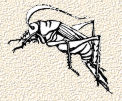Hauntown's Grain Elevator Of Death
I encountered the story while returning from a weekend in Chicago. It was late in
the afternoon and highway construction forced me to detour onto a lonely country
highway. In no time, I was lost and after another hour or so on the road, I rolled
into Hauntown. Taking dinner at the only diner in town, "The Willow Inn", I soon discovered
the waitress, Doreen Hutchens, to be a wealth of local lore. When she learned I
was a reporter, she assumed I had come to see the elevator. Upon explaining that
I was just lost, she laughed and began telling me the peculiar history of the Hauntown Elevator.
According to Hutchens, a man named Rusty Thornson built the elevator in 1927 taking
advantage of the railroad passing through the town. Thornson was rumored to have
been a stingy and mean sort of man who skimped on everything. To stretch the amount
of concrete he planned to use for the elevator, he added a large number of bricks from
demolished buildings. No one knows what sort of buildings or from where they came.
As soon as Thornson's elevator was completed, problems erupted. Workers fell from
ladders, one fell inside one elevator and was horribly maimed by the auger. In 1929,
a steam engine had just switched a car onto the siding adjacent the elevator when
it's water intake valve inexplicably became blocked. In seconds, it burst its safety
valve, sending a jet of superheated steam through the window of the elevator's scalehouse,
scalding the operator, Andy Jones. At that moment, a big overhead auger that had
started feeding grain into the waiting freight car, broke loose and crashed through
scalehouse roof, filling the little house with corn. An instant later, in the presence
of the superheated steam, the house exploded in a plume of popcorn. Andy Jones died
of his injuries two days later.
Not longer after, Thornson himself fell to his death one night from atop the first
of the four elevators, supposedly in a state of severe depression, though some still
maintain he was drunk.
Shortly after, the railroad acquired the elevator and installed Rory MacNeil as manager.
For the next ten years, MacNeil and his assistant, Terry Fin, struggled through
the Great Depression to keep the operation going. One of the four towers began dropping huge chunks of concrete and brick from its roof. Yet, upon inspection by both
MacNeil and Fin, they found no damage what so ever. Eventually, large fissures developed
in the walls of all four towers. MacNeil and Fin did their best to fill and patch
the cracks but to no avail. Late one afternoon, MacNeil discovered a 20-foot crack
in the second tower near where it joined the third. He showed this to Fin and the
two men planned to patch it next day. The next morning, the two men discovered an
identical monster crack had appeared on the first tower but all trace had vanished from
the second.
Throughout the war and into the mid-fifties, the railroad continued to operate the
elevator despite the growing number of managers who hurriedly left the position soon
after taking it. Many claimed of falling masonry but finding nothing amiss in the
roof or walls of the place. Others complained about stinking rotten grain and mildew
but were unable to find any. One man, Albert Wooten, complained of "grimly chirping
crickets and ladders that came loose and twisted about like snakes" and claimed that
late one night in August of 1952, he saw the towers of the elevator rise up slightly and
turn around before settling back into the ground.
In 1956, the railroad sold the elevator to Cletus Macabie who'd played in the shadow
of the elevator as a boy. He never said anything about strange happenings at the
elevator while he ran it, and dismissed the old stories as "too much moonshine, too
little work". Miraculously, he turned a profit with the elevator until September 12,
1973. On that morning, he was discovered dangling from a rope around his neck and
covered all over by fat, pale-yellow crickets.
I wanted to inspect this marvelous place. And after following Hutchen's directions
through town, I found the drab gray concrete towers along the rusted railroad siding
at the north end of town. As I drew near, I discerned the concrete of the towers
to be flecked with little bits of red brick, a few the size of my fist. The were no
cracks in the walls, no sign of any sort of structural decay, just the few creepers
and saplings growing around the base. The ground was littered with broken glass
and rotted planks of wood. I found the door into the office adjacent to the towers and walked
in through the freely swinging doorway. It was a snug little building with a blackened
pot-belly stove in one corner and heavily water-damaged oak desk in the other. The floor was littered with trash and dried leaves which crackled as I walked to a
door in the far end of the room.
As soon as I opened the door, a wave of musty, stale air curled about me. Only after
my eyes adjusted did I realize I had entered the first of the grain elevators. It
was very dim and as I took another step, more trash and leaves crunched and scattered
noisily at my feet. Unable to see, I drew out my key chain and turned on the little
flashlight I kept on the ring. As I shown the beam about the floor, I suddenly realized
it was seething, milling, and pulsing grotesquely. I screamed and fell back against the door which slammed shut with an echoing bang behind me. The floor was alive
with pale yellow crickets, crawling and quivering. Their thunderous chirping echoed
and distorted in the vast cylindrical blackness of the tower, sounding more like
a malevolent and nasal "eh-eh". At that instant, a large boulder of concrete toppled noisily
from above, missing me by inches, and smashing into the midst of the wriggling horde
at my feet. Bug innards spattered all over my pants. I got angry. Someone was
up there, I thought, and I was going to get him. In the dimness, I found a steel ladder
anchored in the concrete wall. Crunching my way through the chirping mass to it,
I started climbing upwards.
I had climbed about thirty feet or so when from out of the blackness above another
chunk of concrete hurtled down straight at my head. I hugged the ladder as best
I could. The chunk struck the steel ladder rung just above my head and rolled away
lightly along my spine. More masonry debris clattered about me, but did no damage. I only
grew angrier and made myself climb faster.
Soon, I noticed the chirping had changed. It sounded strangely human, like a bitter
old man who smoked cheap cigars. "Die!" it rasped, "Die-Die! Die-Die!"
The ladder suddenly wrenched away from the wall and twisted about as if it were alive,
moaning and squeaking horridly. I clung desperately as it snapped above me and I
helplessly rode the broken ladder as it hurtled through the dark. It howled as it
caught against the far wall and held firm. An eery silence gripped the place, even the
crickets held their perverse chant. Feeling trapped, I lost no more time, but clambered
down hand over hand until I reached the last stretch of ladder still attached to
the wall. I soon reached the floor and felt my way back to the door. At first, I
couldn't find the knob and then it wouldn't open. But after tugging hard, I jarred
it loose and escaped.
I staggered out squinting just as the sun was setting.
"Evening, ma'am," came a man's cheery voice. I blinked and saw it was the town's
police officer, Bob Mallory.
"You know it's dangerous to go crawling around in that old ruin," he warned.
I told him my story and explained that I thought someone had been deliberately trying
to harm me by throwing concrete and rubble at me from above. He nodded and drew
out a large flashlight and followed me back into the elevator.
When we entered the bottom of the tower, the officer's light showed no trace of disgusting
crickets, nor either pieces of concrete that had been hurled at me. So too, the
steel ladder was firmly anchored back in the wall. No trace existed anywhere of
any damage or trash; in fact the whole floor was bare and covered with a thick coating
of dust. Not even my foot prints were visible.
I took his advice and arrived home about an hour later. I couldn't help, though,
thinking of my adventure in that deadly elevator. I plunged headlong into diligent
research but all in vain. I found no reports of ghosts or hauntings ever occurring
at that drab gray place. Nor is it listed in Morganna Oley's cryptic Atlas of Spiritual Forcelines in Iowa. I only know that the Hauntown Elevator stores mysteries. And they are dangerously
evil mysteries, too.

Back to this Issue Contents
